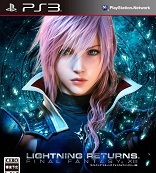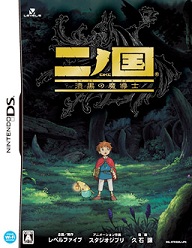« Tales of Graces: TGS 2009 Hands-on | Main | Final Fantasy IV for DoCoMo phones: TGS 2009 Hands-on »
Hikari no Senshi: Final Fantasy Gaiden : TGS 2009 Hands-on
By Janelle | September 27, 2009 at 8:04 am
It started out innocently enough. I was prompted to name four characters (two boys and two girls) and then the demo began. A mother woke up my character, and with little fanfare, I was off on what turned out to be a deceptively complex and fun journey. What I could understand of the dialogue seemed pretty tongue-in-cheek. The opening town really brought out the stylistic beauty of the graphics. The fields of grain ruffling in the wind particularly stood out as an impressive visual. In wandering around the town, characters make mention of the different aspects of the game’s system, and some shops are available as well.
How the game works is a little different from what one would normally expect from a Final Fantasy derived game. Each character has no particular specialty in their normal forms. They have an attack command, an item command, and six slots for battle skills. Battle skills could be a command like “Steal,” or a spell like “Cure” or “Fire,” but won’t encompass both. There is no “Black Magic” command that’ll contain all the spells the character knows. That’s because a character can only cast the spells whose scrolls they have in their inventory. Each character has 15 inventory slots that have to contain all spells and items that the player wants available for that character, as well as the character’s equipment. It really limits the functional ability that each character individually has, and definitely promotes building a cohesive team rather than single powerhouse characters.
Characters have average statistics, like magic and speed, across the board until they put on a Crown. Crowns could be called the Job system of Hikari no Senshi. Crowns alter a character’s statistics, and make abilities available for use in battle. Putting on the Thief Crown increases the character’s speed and attack power and lets him use Steal, for example. Crowns can also be leveled up to gain access to new abilities. Gems received in battle must be inserted into the Crowns to increase their power, with different Crowns requiring different combinations of gems. Crowns are different for each character, so leveling up one character’s Crown does not change the others’s Crowns. In writing this, I realize I forgot to check whether abilities learned from one Crown can be used if that character switches Crowns, but the answer will be important to the strategy of the full game in the long run.
Though it looked like there were between 30 and 40 Crowns in the game, the demo made about seven available, including such classic roles as Black Mage and White Mage. I threw together a party wearing the Crowns of Thief, Black Mage, Bard, and something that might have been either a Sage or a Geomancer. Since spells are confined to inventories and not jobs, I played through the whole demo without actually remembering to transfer the Fire spell to my Black Mage, who had to settle for Cure. Fire was definitely less useful on my Thief. The incident can be an anecdote for the importance of managing one’s characters well in Hikari no Senshi.
In battle, every character has slots that can store up to five points, and typically gain a single point at the end of each turn. Most attacks consume a single point, but more powerful spells and skills require a greater number of points. Thus, on a regular basis, I was faced with a decision: do I pepper away with regular attacks, or save up for a rainy day in case I need a Cure spell? The possibility for strategy became obvious very quickly.
After exploring the overworld briefly and fighting some random battles, I encountered a dark cave. The dungeon was brief, with a few treasures, but the enemies provided a jump in difficulty that was a pleasant surprise. During this experience, I discovered that the Cure spell wasn’t targetable, and defaulted to the most damaged character, which was a little disappointing, since it ignores the player’s judgement on which characters are more valuable to let live. After a few floors, a boss attacked, who took a long time to kill. He was a perfect example of how the system should challenge the player. Often I had to forgo plans of saving up points for powerful fire spells in order to hastily cure my party after he would hammer them, or sacrifice attacking to put powerful buffs in place a few turns later.
After beating the boss, the characters all lined up and bowed. “Thank you for playing the demo! Did you have fun? Y/N” It would have been funny to say no and see what happened, but then I would have been lying. I enjoyed the demo thoroughly. The game’s system had just enough elements from the Final Fantasy series to be familiar, but obviously wasn’t a cop out on series’s ability to be a perpetual cash cow. Hikari no Senshi looks like it’ll be a robust game, with an intriguing system and real strategy buried under the cute facade and name.
Topics: Hikari No Senshi: Final Fantasy Gaiden (Four Warriors of Light), Previews, Tokyo Game Show 2009








